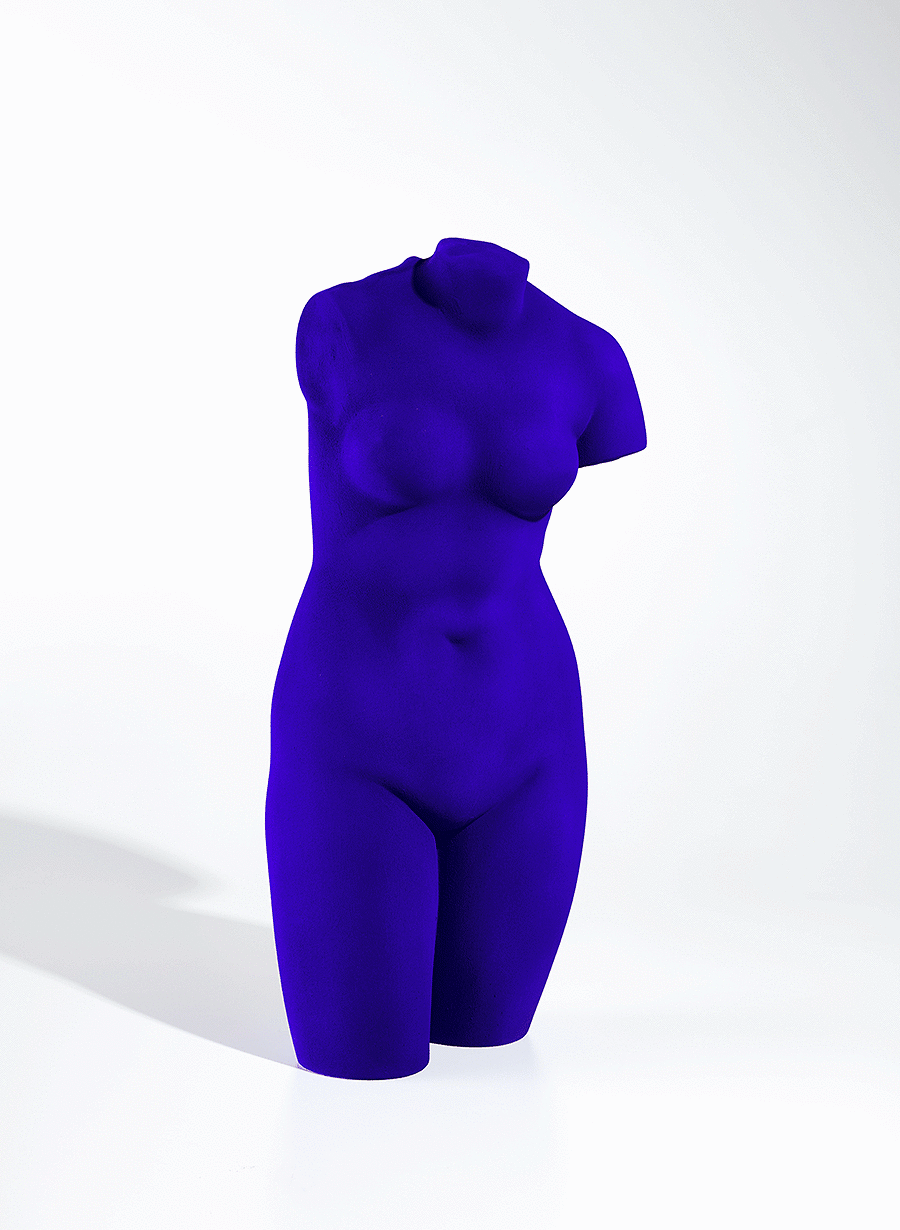Yves Klein, Le Vènus d'Alexandrie (Vènus bleue), 1962-1982. Editions & Works on Paper, New York.
Every great collection tells the story of the collector behind it. For Robin (“Binnie”) Quist Gates, it was her warmth, humanity, curiosity, and, of course, excellent taste that became the foundation of the work she collected.
Our Bay Area regional lead Sophia Kinell sat down with family and friends who knew Binnie Gates best—her granddaughter Sarah Wendell Sherrill, co-founder of art technology company, Lobus; John Berggruen, owner of Berggruen Gallery in San Francisco; and Denise Erickson, professor of art history at Cañada College. In reflecting on Gates’ legacy, they also illuminate a core element of so many great collections: how to bring people together.
SOPHIA KINELL: I want to start at the beginning and with you, Sarah. When and where did Binnie’s spark with art start?
SARAH WENDELL SHERRILL: I'm so glad that Denise is in this conversation because I think she is really where it started. My grandmother went back to school around age 50 and fell in love with art and art history. She was taking classes at Cañada College and San Jose State, and she found that art really energized her. She always had an incredible eye, and was drawn to sculpture early on. It was at Cañada College where she first discovered Henry Moore.
My grandfather had an investment bank out here on the West Coast that was responsible for taking early technology companies public, including Apple and Genentech. He tragically passed away and my grandmother was given advice “Buy something that will make you happy” and for her that was Henry Moore. Back to those art history classes, Henry Moore was one of her favorite artists. She asked where to find sculptures by the artist and was told about Marlborough Gallery in New York. She traveled there alone for the first time, looked at one and bought it, which led to a series of experiences and friends and relationships that really catapulted, I think, her love of art, her love of people, and her love of travel.
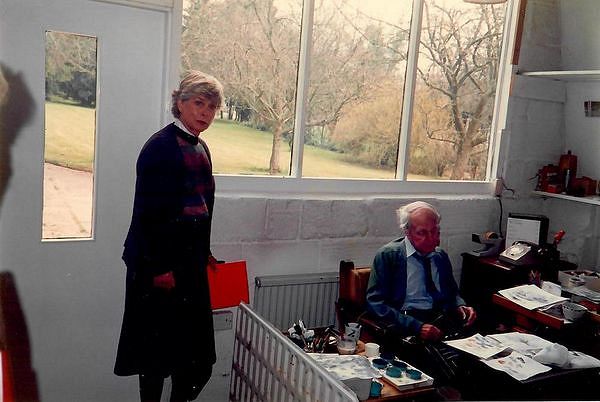
Binnie and Henry Moore in his studio, 1985.
SK: Denise, you were instrumental in cultivating Binnie’s initial interest in art at Cañada College. Can you tell us about how you first met? Was Binnie a good student?
DENISE ERICKSON: I was at Cañada College teaching art history and this wonderful woman showed up in my class. She was a top student. And I'm not just saying that! She was just an outstanding student.
On one of my first art trips down to Los Angeles, Binnie and I sat next to each other on the plane. For the next hour on our trip south, she told me this wonderful story about how she had a very close friend, Shirley Davis. Shirley was just getting into collecting and was very active at SFMoMA, but Binnie wasn’t quite there yet.
After George died, which was just a horrendous shock, Shirley invited Binnie on a Collector’s Forum trip to London. So off they went, and one of the features of the trip was a visit to Henry Moore’s estate. So she went and she met Henry Moore, and she was with people who loved art, and that was a very nurturing environment. When she went to Moore’s studio, he had some works there that she fell in love with. At this point, she had already purchased her first that sat outside at her home in Woodside, silhouetted against the vineyards and reflecting against her swimming pool. It was a spectacular entrée into this world.
Somewhere along the line, Binnie being Binnie said, I don't want to do all this unless I know something about art. So she decided to take the art history classes that Cañada College right up the hill from her. And that's when she started taking my classes to fully appreciate this experience and to learn more. She didn’t just take the course in modern art—she took antiquity and classical and renaissance art, even though it wasn’t really her taste. But she wanted to know it all.
She traveled with me many times, and it was always such a joy for me when I realized Binnie was coming on a trip because she always had such incredible insights.
SK: John, many of the works in this collection came from Berggruen Gallery. I understand Binnie would visit you up on Grant Avenue and you would visit her down in Woodside? How did you first meet?
JOHN BERGGRUEN: I met Binnie coming into the gallery. And I think one of the great, great qualities that Binnie exemplified was her curiosity. She was always interested in different things, and open to ideas, and had a great sort of energy about her. And a sense of humor, which is very important, I think. But the curiosity factor, and that she loved the idea of the participation, and the discoveries, the journey, the experiences. So all the ingredients sort of clicked together. Visiting her down in Woodside was always a pleasure. She was a very warm, dear friend.
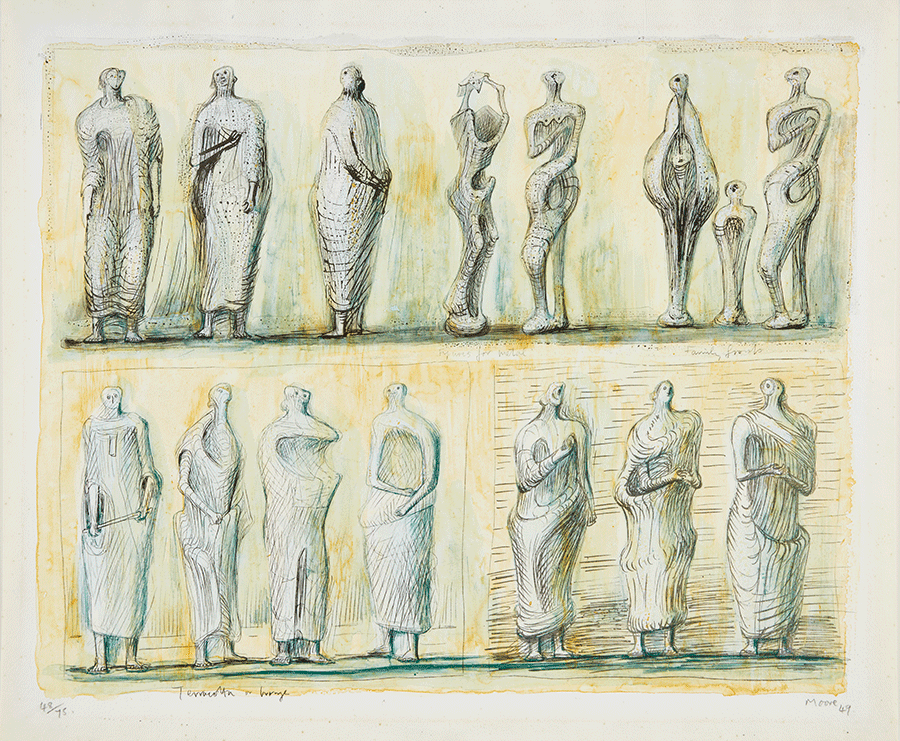
Henry Moore, Standing Figures, 1949. Editions & Works on Paper, New York.
SK: How would you describe her collecting? Was there a particular kind of work that she was drawn to?
JB: I would say the word eclectic would be an apt adjective. She also had things that were personal to her. It wasn't about collecting art that was chic or trendy. She was independent that way—she had her own eye, her own taste and her own vision. So it could be quite varied, which was part of the surprise. One of the great things about having an art gallery is when people walk in, they're looking for something, but then they turn the corner and they see something else. It's a surprise, and perhaps it pushes them or leads them to a different direction.
SK: The collection includes works by several Bay Area artists—Richard Diebenkorn, Elmer Bischoff, David Park, Paul Wonner, Theophilus Brown, Wayne Thiebaud. Can you tell us a bit about these acquisitions, that element of discovery you touched on and talk to us about how you helped shape the collection?
JB: These were artists that I either represented or specialized in. It would appeal to her in terms of the whole sensibility of Bay Area figurative art, and those artists were pretty exceptional. By coming to me, she would see a selection of works by those artists in varying degrees. And it was one-stop shopping. She wouldn’t see those works elsewhere, even in New York because it was more of a West Coast thing.
I think a lot of clients become good clients because they have a rapport with the owner of the gallery, and in this case, it was me and my wife, Gretchen. We both had a great rapport with Binnie. It was very meaningful, and we liked her so much. I was sort of an extended member of the family.
SWS: John was very important to my grandmother. She had so much joy being with him, visiting him. It was a lifelong friendship.
DE: And in her collecting, she felt so confident about his guidance and opinion and direction. And that was very, very important to her.
SWS: She cared about people. It was as much about the people she met along the way as the actual objects. I think about John and Gretchen and her relationship with them, and how deeply meaningful that was. She was very people-oriented.
DE: She also really loved sharing her art with other people. Whenever she had a dinner party, she was always very generous. She didn’t go on and on about her collection, but it was something she loved. Just as whenever we have anyone in our space, and we fix them a nice meal and want them to have a good time. Binnie’s art collection was something she loved sharing with other people and seeing their enjoyment and appreciation of it.

Richard Diebenkorn, Blue, 1984. Editions & Works on Paper, New York.
SK: I love that and I think this ties into her support of museums as well. Beyond what Phillips is offering, Binnie collected several large-scale sculptures early on, which are now housed in important Bay Area institutions—Claes Oldenburg at the Cantor Arts Center at Stanford and Henry Moore at the de Young. She was also a longtime supporter and Trustee of SFMoMA. Sarah, why was this important to her?
SWS: I think it comes back to the people again. With SFMoMA, it wasn't in pursuit of being involved with an institution. She was naturally drawn to the experiences that she had with SFMoMA under John Caldwell and Jack Lane. Same with Director Harry Parker at the de Young, and her second husband Ned was also involved with the construction of their new Herzog & de Meuron building. She gifted Claes Oldenburg’s Soft Inverted Q from 1977 to Stanford University, a playful reference to our family name. We have a long history at Stanford. Her father was the track coach there for many years, she and her sister basically grew up on campus, and she met her husband there while she was working at the bookstore and he was playing football. Stanford was always a very meaningful place to her, and it just felt natural that one of these pieces would find their way there.
She always showed up, she was always generous. She never viewed her art as an investment or as an asset, or as anything other than joy that it brought into her life. For her, sharing it with an institution she cared deeply about, that was run by people that she cared about, enjoyed by people that she cared about, was just fun for her.
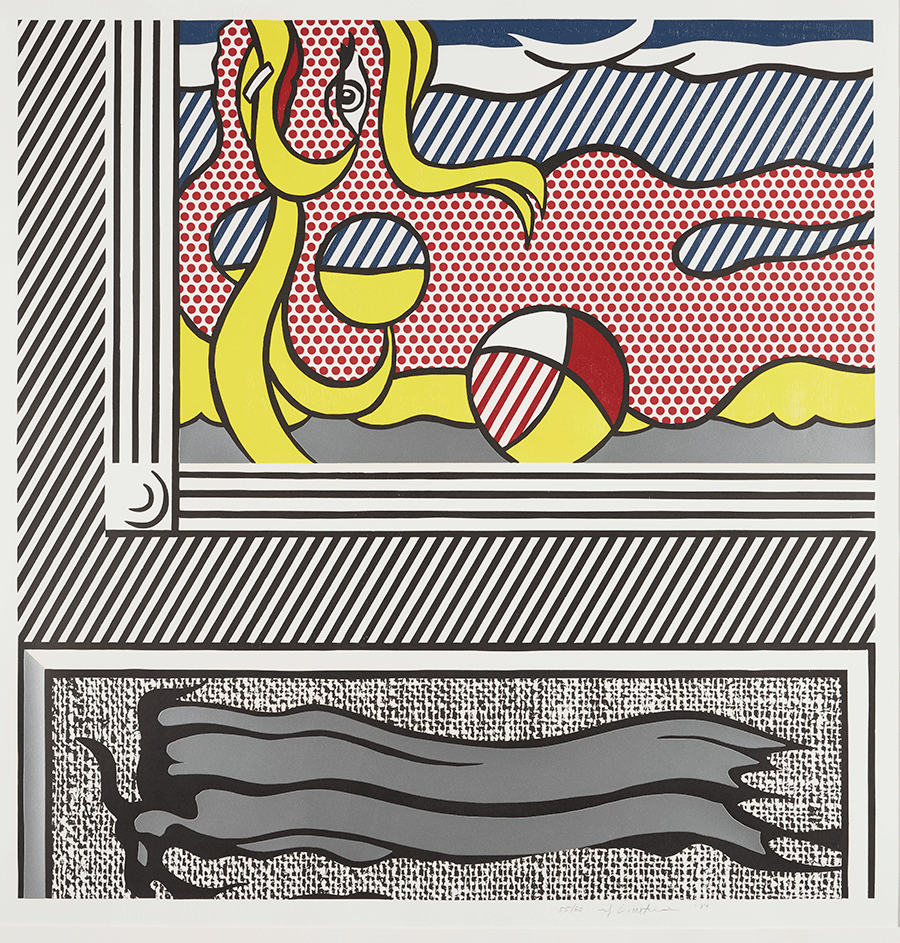
Roy Lichtenstein, Two Paintings: Beach Ball, from Paintings Series, 1984. Editions & Works on Paper, New York.
SK: The works in this collection were truly loved and lived with. Can you tell us about Binnie's philosophy around art and how it has shaped your own? What was it like growing up around her art? How did she live with it?
SWS: She really lived with the things that she loved and not the other way around. She had a sense of humor with how she lived with art, and how she put things together. In her later years she found a great Greyhound bus sign, 10 feet long I think and quite heavy. She mounted it in her kitchen across from a Jenny Holzer ticker tape.
DE: She had an Etruscan-like Tom Otterness frieze that he made for her dining room, and of course she learned about the Etruscans and their erotic paintings in her art history classes, and if anybody asked her about it, she said, “Well, they're being a little naughty.” They were being naughty, but she just loved that. She loved the playfulness of her collection. She didn't try and make it overly pretentious or overly serious, although she had very discriminating taste.
SWS: Things were not precious. She lived with these things. We used to sunbathe on the Henry Moore and climb all over the Barry Flanagan hare she had in her garden. She had a Lalanne sheep outside of her front door that we would sit on. She had David Gilhooly oreos and ice cream cones we used to play with. She would get invitations to all of John’s shows and frame them because she liked the images—she had a little Wayne Thiebaud cupcake invitation framed on her desk. She just loved living with fun and beautiful things. Her confidence came through her eye. Art was a manifestation of this. She trusted her gut. But again, she never took this too seriously—she loved to shop and she had great taste and an eye she trusted, she loved discovery and the thrill of a buy.
JB: I think the concept of shopping is important. Some people don’t want to make the commitment of an acquisition, but she was courageous that way. She didn’t overthink things.
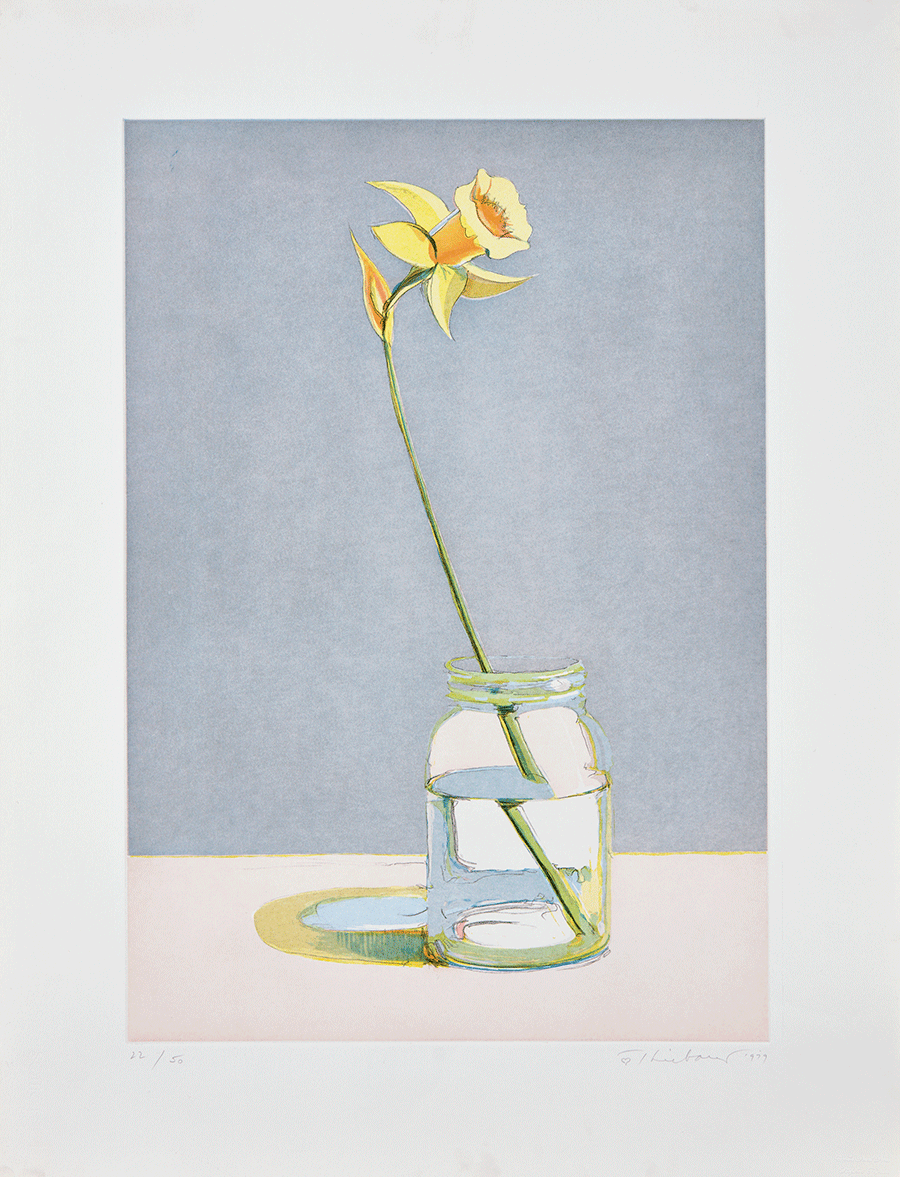
Wayne Thiebaud, Daffodil, from Recent Etchings I, 1979. Editions & Works on Paper, New York.
SK: My understanding is that Binnie didn’t set out to build a certain type of collection, which makes the connectivity all the more astonishing. From modern masters Milton Avery, Henri Matisse and William Turnbull, to the colorful compositions by California based artists David Hockney, Paul Wonner and Wayne Thiebaud, this collection bridges nearly a century of art history. Can you speak to the through line that is evident here?
DE: I think the through line is Binnie. Color is certainly a theme that runs through those artists, but I think another is the combination of humanity, warmth, and playfulness. And that was just a reflection of who she was, and it’s why we all wanted to be around her. We all loved her art collection because the things that she loved spoke to everyone that loved her, as well.
She was incredibly intuitive. And there was nothing about her that looked calculated or planned. There is also an appreciation, I think, in the works of art that she collected for a natural, instinctive composition. The Paul Wonner is one of my favorites. It has a very formal structured quality to it, and the colors kind of rhyme with one another. All this stuff is so instinctive. And that's true for Binnie as well. That's why everybody loved being around her.
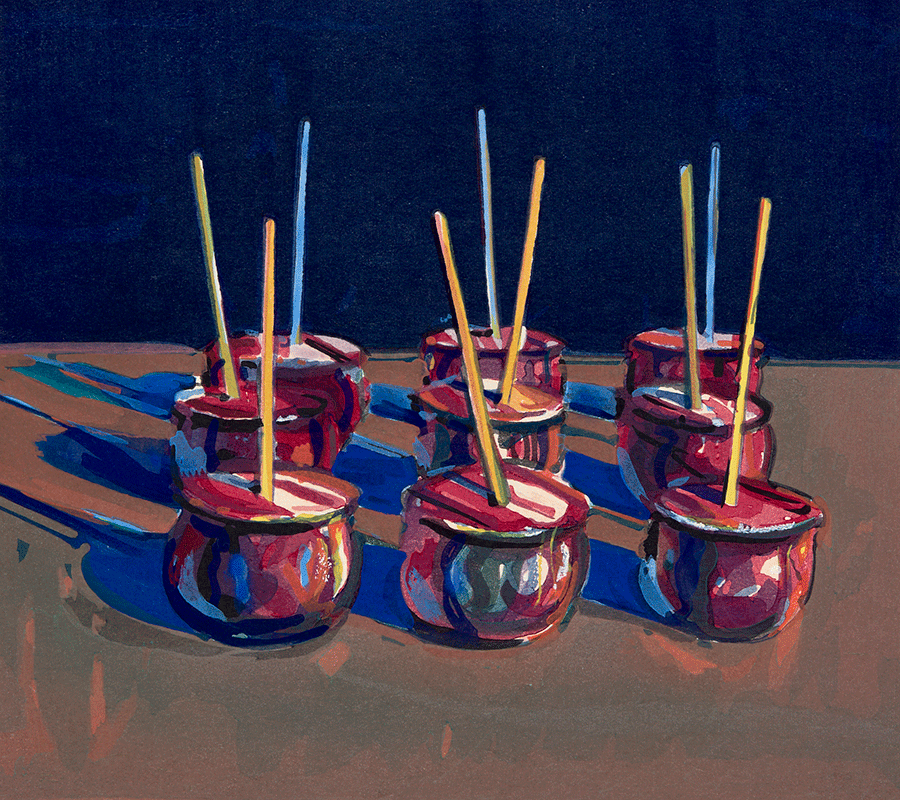
Wayne Thiebaud, Candy Apples, 1987. Editions & Works on Paper, New York.
SK: Sarah, how has this all informed your personal approach to collecting and how do you think about people approaching collecting for the first time?
SWS: I basically think that it's to live with and buy what you love. First and foremost, what grabs you is probably right. I've learned a very unprecious way of living with beautiful things. My grandmother had beautiful taste, and it was so subtle. She wasn't about what anyone else was buying, it was just very embedded in the way that she lived with art, decorated her home, looked at her gardens. Nothing was premeditated for her. It was so effortless. She didn't discriminate between painting and sculpture and prints or reproductions. In her dining room, she had a great Lichtenstein print that she loved. She mixed and matched throughout, and lived with all mediums. Prints are very accessible from a price point, and are often the best way to access an artist’s body of work.
I think the other thing I’ve learned is that objects and people are inextricably linked. Her love of art was so deeply connected to the people that she met along the way—the relationships it built for her, the experiences that it formed, the way it all opened up her world.
Recommended Reading
Legacy in 3D: Property from an Important Private Japanese Collection >
The Statesman, the Magnate, and the Original 'Superyacht' >
